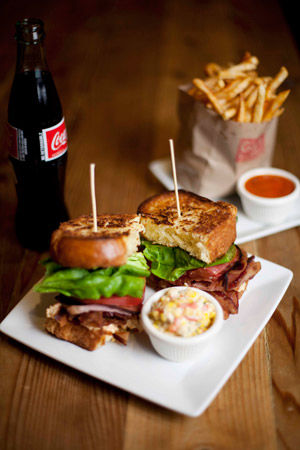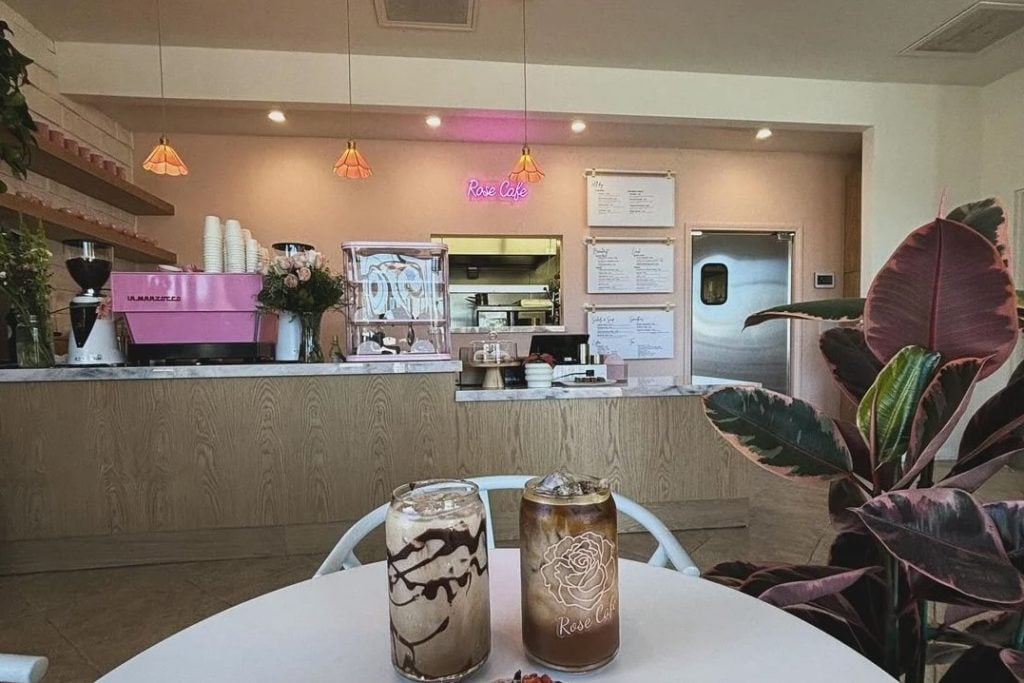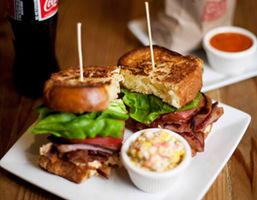
Photo of the Pork Sandwich from Carnitas’ Snack Shack
Pork Sandwich from Carnitas’ Snack Shack Photo by John Dole
The man in the tuxedo looks frightening. Not violent, but emotionless. As if he sleeps standing up with his arms plugged into a socket. I am a fraud, and both he and I know it. It won’t be long before he escorts me by the shirt collar into the basement where I’ll be forced to tongue-wash the luxury autos of the true dignitaries in attendance.
My suit is a decade removed from current fashions, and one or three sizes too large. The room is uncomfortably quiet, as if someone’s dead grandma is in a box nearby. My hands and arms—parts I usually spend zero conscious thought on—seem conspicuous, out of place, awkward. I fold them in front of me on the table, but that makes me think of Jesus and the things I’ve done to disappoint him. So I put them in my lap and clear my throat. No good reason for the throat-clearing, really. I just wanted to make noise and be part of the conversation without actually talking. Because talking would reveal that I don’t have the conversational skills required in a well-carpeted place like this.
All this before bread arrives.
Why would I want to dine on a hotel bed sheet? And why is Mr. Roboto constantly scraping the crumbs from my part of the table with what appears to be a barber’s shaving blade or a really nice prison shank? Should he be monitored for sociopathic tendencies? Give me pizza. Or ramen. Or ramen on a pizza. Something cheap-and-easy on a couch or in a park. Let me wiggle and scream and throw scraps on the floor. That’s how I wanna eat.
That’s my first memory of dining at Mr. A’s on my stepmother’s birthday in 1980. I was seven. My father took us, and I loathed every minute of it.
Now age 40, I still listen to music way too loud and am often shoeless. But I love Mr. A’s. I learned to love it for holding me—wrinkled, un-combed, uncouth, flip-floppish me—to a higher standard.
Today Americans seem to identify more with my seven year-old self. The prevailing attitude is that fine dining is a stiff, awkward exercise in pretention. Dining for poodle owners. Grande cuisine is dead. Bring on the artisanal pizza and craft beer, served in a former auto shop (authentic oil-change stains!) with the Black Keys’ swamp-rock cranked to 11 and underarm hair poking out from tank tops of patrons everywhere.
It’s partly due to the casualization of America, which has been happening for decades. It’s been quite a while since we twirled our parasols in the public park or tipped our top hats to ladyfriends. Casual Fridays grew into Casual Decades. And San Diego is especially laid-back. Never to be confused with Milan, our beach-vacation fashion sense is open-toed, cargo-shorts’d, tank-topped, and cotton-centric. We dress like dharma bums, proudly.
The hyper-casualization of American restaurants really took off in 2008, when the economy took a nosedive off a tall, over-leveraged building. Formal, quiet restaurants were shuttered and informal, loud joints have replaced them. People began eating duck confit in skinny jeans and Chucks.
San Diego’s highest-profile success story of this trend came from Tracy Borkum, who stripped her ultra-modern Laurel and made it into the casual, come-all rustic Italian dinner party that is Cucina Urbana. She sold very nice furniture on the sidewalk to prove her point—a public execution of fine dining. There’s also Carnitas Snack Shack, where Hanis Cavin sells three-star food (pork belly) out a one-star window.
I love these joints. They serve food that’s every bit as good, if not better, than formal dining rooms. And yet you can wear last night’s jeans and use them as a napkin! (Actually Borkum might not approve of that, but Cavin certainly would).
Those restaurants aren’t the problem. They represent the best of their class. The problem is everyone—and I mean everyone—is crashing that class.
The trend is understandable. When the recession made us all jobless and homeless, upscale monocle-dining seemed highly insensitive, or downright gross. Diners began to flock to restaurants like Animal (L.A.) and Spotted Pig (NYC), highly awesome places that look like gourmet thrift stores designed by people on drugs.
But I think we’ve gone too far . Every new restaurant tries harder and harder to look like a rock dive. Exposed concrete floors, reclaimed woods, servers in t-shirts, stereos maxed out with some Coachella-bound indie band with a precious name.
Even high-end restaurants are casualizing. It reminds me of when corporate record labels co-opted punk rock. Or Pat Boone’s heavy metal record.
The great thing about this trend is what it’s doing to the casual dining realm. Without spending eegads on designer furniture and light fixtures, great chefs are able to save money for what matters. Namely, food. The quality at under-$20 restaurants has never been higher. The barrier for entry for young, creative restaurateurs has never been lower. You can do quality without spending a gazillion—and now customers realize that, too.
But let’s not fool ourselves. Very few of these supposedly “affordable-gourmet,” under-$20 restaurants are actually cheap. Designed as “share plates,” you end up spending damn near what you would at a fine dining spot. So it’s not really about saving the customer money.
It’s about how we want to eat.
This month, French restaurateur Jerome Gombert shut down his romantic, upscale South Park bistro, Vagabond. This analysis makes no effort to measure Vagabond’s food quality, service, location, cost, etc. What it does take into consideration is something he told me on the way out:
“San Diego just wants a burger and a beer. That’s not what I want to do.”
Nine times out of 10, I’d rather eat somewhere like Cucina Urbana than a quiet, romantic place like Vagabond or Addison at the Grand Del Mar. Food simply tastes better in jeans. But I want a neighborhood version of Addison. I want restaurants that challenge me to “fu**ing iron something, Troy. Google ‘Windsor knot’ for the 30th time. Just… try.”
If all we end up with is really loud, unromantic party-bistros that look like CBGB, we’ll curate a populace that never, ever fu**ing irons something. What seemed like a fresh movement in the dining scene—roasted bone marrow in an abandoned Salvation Army dropoff center!—begins to look commonplace, predictable, tawdry.
Getting dressed up to go out to a formal dinner isn’t like the hand-cranked automobile. It’s not a dinosaur overdue for euthanization. It’s a tradition that challenges us to pay occasional respect to formal American customs, from fashion to nuances (and volume) of conversation.
We should give it a try. And build a couple more. Or we could all just eat elk medallions loudly in our sweatpants.
Over the next week, SD Food News will publish responses from the San Diego restaurant and food community about this debate. Tomorrow, we’ll hear first from Bertrand Hug, owner of Mister A’s.
Watchou think? Like the casualization of San Diego restaurants? Even if it means you have nowhere to have a quiet, romantic dinner with your wife or grandma?
















